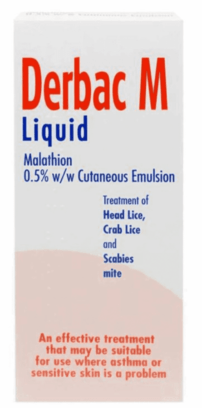Before we can issue a treatment, you’ll need to answer a short assessment. This assessment will help us recommend the right treatment for you.

Derbac M Liquid 150ml - Scabies Treatment
From £17.99
Permethrin (Lyclear) 5% Cream - 30g
From £12.99
Our site uses cookies. By continuing to use our site you agree to our cookie policy.
Free standard delivery on orders over £50
Before we can issue a treatment, you’ll need to answer a short assessment. This assessment will help us recommend the right treatment for you.
Explore proven remedies and expert advice for managing scabies. Discover medicated creams, natural solutions, and preventive measures to alleviate symptoms and eradicate mites. Take control of your well-being with our curated selection for a scabies-free life.


Scabies: Overview
Scabies is a parasitic skin infestation caused by the tiny mite Sarcoptes scabiei var. hominis. These mites burrow into the skin's outer layer, leading to intense itching, particularly at night, and a red, bumpy rash.
Scabies primarily spreads through close skin contact with an infected person and can affect various parts of the body, including the wrists, fingers, armpits, and groin.
Scabies mites burrow into the top layer of the skin, where the adult female lays eggs. The eggs hatch in 3–4 days, developing into adult mites in 1–2 weeks. Allergic reactions to mite proteins and feces in the burrow cause intense itch and rash after 4–6 weeks.
The scabies mite belongs to the Acarina group and has a life cycle consisting of four stages:
Scabies is highly contagious and spreads through prolonged skin contact. Although less common, it can also spread by sharing clothing, towels, or bedding with an infected person.
Although they can survive off the body for a short time, they need the warmth and moisture of human skin and quickly die without it. This means they can't easily move to new people and require direct, prolonged contact for transmission.
Classic Scabies: This is the most common type, causing intense itching on the hands, wrists, elbows, and between fingers.
Nodular Scabies: This type creates itchy, raised bumps or lumps, especially around private areas, armpits, or the groin.
Crusted Scabies: This is a more serious and highly contagious form of scabies, also known as Norwegian scabies. It creates thick crusts on the skin containing large numbers of mites and eggs.
People with weakened immune systems, like those living with HIV, using certain medications (such as some for rheumatoid arthritis), or undergoing chemotherapy, are more susceptible to developing crusted scabies.
Scabies can occur on various parts of the body, and the common areas where the infestation is often found include:
Scabies can be problematic for several reasons, and the most challenging aspects include:
Intense Itching: The persistent and intense itching, especially at night, can significantly impact one's quality of life and disrupt sleep.
Contagious Nature: Scabies are highly contagious and easily spread through close personal contact, making it challenging to control outbreaks, especially in crowded environments.
Diagnostic Challenges: Figuring out if you have scabies can be tricky because they look different for everyone and can seem like other skin problems. This might make it take longer to get the right treatment.
Treatment Resistance: In some cases, scabies mites may develop resistance to certain treatments, requiring adjustments in the therapeutic approach.
Impact on Vulnerable Populations: Scabies is more prevalent in low-income tropical areas, affecting vulnerable populations such as children and older individuals. This can make health differences worse and make it harder to fix the problem.
Complications and Secondary Infections: Scratching the itchy rash can lead to open sores, increasing the risk of bacterial infections. In severe cases, complications such as cellulitis or impetigo may occur.
Psychological Impact: Persistent itching and visible skin manifestations can have a psychological toll, causing stress, anxiety, and discomfort for individuals dealing with scabies.
Dealing with scabies needs a good plan, like getting the right treatment, and making sure it doesn't spread around too much.
To avoid getting scabies, it's important to keep a few simple steps in mind. First, always wash your hands and stay clean.
https://www.ncbi.nlm.nih.gov/books/NBK544306/
https://www.who.int/news-room/fact-sheets/detail/scabies
https://www.nhs.uk/conditions/scabies/
https://www.nhsinform.scot/illnesses-and-conditions/skin-hair-and-nails/scabies/
https://www.webmd.com/skin-problems-and-treatments/ss/slideshow-scabies-overview
https://www.nhs.uk/conditions/impetigo/
The mites responsible for causing scabies are tiny parasites (an organism – a parasite that lives
on or inside another organism – the host) smaller than a pinhead, scientifically known as Sarcoptes scabiei var. hominis.
The mites burrow into the outer layer of the skin, where they lay eggs, and trigger an allergic reaction, leading to the characteristic symptoms of intense itching and a rash.
The mites are primarily transmitted through close personal contact (sexual activity) with an infected person, and occasionally through shared clothing, towels, or bedding.
People with scabies usually have around 10-12 adult mites on or in their skin, although some may carry more.
Scabies is easily spread between individuals, but it is not caused by a lack of cleanliness.
In rare cases, a severe form called 'crusted scabies' occurs in individuals with a weakened immune system or those who are elderly and ill. This variant is highly contagious, with thousands of mites on the skin.
It's important to note that scabies in animals are referred to as 'mange,' caused by a different type of mite that cannot live on or in humans.
Scabies medications
For scabies treatment, doctors typically prescribe topical ointments, creams, or lotions, while oral medications may also be prescribed in some cases.
The medication is typically applied at night, as the mites are most active then, maximizing treatment effectiveness.
It's usually necessary to treat the entire body from the neck down, and the medication can be washed off the next morning. This process is often repeated for several days or weeks. Common medications for scabies include:
Derbac M (malathion) lotion. 5% permethrin cream, 25% benzyl benzoate lotion, 10% sulfur ointment, 10% crotamiton cream, and 1% Lindane lotion, Oral ivermectin
PATIENT INFORMATION LEAFLET SCABIES
Advice for Topical Scabies Medication
When using skin treatments for scabies, put the medicine on ALL of your skin, not just the itchy parts. The mites could be anywhere, so covering all areas ensures better treatment. Follow the instructions carefully for effective use.
The most common symptoms include unbearable itching, especially at night when the mites are more active, and the development of small, red, raised bumps. The infestation typically affects areas like fingers, wrists, elbows, and the groin.
It can also make your skin sore and, in rare cases, lead to secondary infections. Doctors treat it with topical creams/lotion or pills.
https://cdn.bad.org.uk/uploads/2021/12/19174008/Scabies-update-PIL-Oct2023.pdfWhen someone is infested with scabies, the symptoms typically develop after an incubation period, which is the time between initial exposure to the mites and the onset of noticeable signs.
If you've had scabies before, the itching usually starts within 1 to 4 days because your body recognizes the mites and reacts quickly.
However, if it's your first time getting scabies, your immune system needs more time—about 2-6 weeks—to react and show symptoms like itching and skin problems.
So, how fast you notice the signs depends on whether your body has dealt with these tiny mites before.
The symptoms of scabies include:
First time: For someone newly infected with scabies, it can take 4-8 weeks, up to 2 months for symptoms to appear on the skin. This delay is due to the time it takes for the immune system to react to the presence of the mites.
Repeat infection: For someone who has had scabies before, the itching usually begins within one to four days after reinfestation, as the immune system responds more rapidly.
In the UK, two main treatments are available for scabies: permethrin and malathion. Unfortunately, Since September 2023, there have been shortages of both for several months.
This shortage is due to a combination of issues, including problems in the supply chain, the conflict in Ukraine, and an increase in the cost of raw materials. As a result, people may be facing challenges in accessing these essential treatments for scabies.
Yes, there is evidence of a recent increase in scabies cases in the UK, potentially linked to a shortage of treatment medications.
In late November 2023, the number of cases was reported to be twice the usual seasonal average, with a rate of 3 per 100,000 people. This information was reported by [The Guardian News].
However, it's important to note that this data is from late 2023, and the situation may have changed since then. For the most up-to-date information and guidance, please refer to reliable sources like the British Association of Dermatologists (BAD) or the National Health Service (NHS).
Yes, scabies can be cured with the right treatment. Prompt and appropriate treatment leads to a quick and complete resolution of the condition.
However, if left untreated, scabies can persist for months or even years. It's crucial to treat all affected individuals and anyone who may have had contact to manage symptoms, prevent complications, and curb further spread of the infestation.
Scabies is not hereditary, but it can be common for several members of a family to have scabies at the same time due to its easy spread in close living quarters.
The condition is primarily transmitted through direct skin-to-skin contact or, less commonly, via shared clothing, towels, or bedding.
The treatment might sometimes cause skin irritation, leading to an ongoing rash and itch. You can use moisturizers (emollients), steroid creams, or antihistamine tablets if needed. Please ask your doctor or a pharmacist.
If skin issues persist 6-8 weeks after treatment or if you're still worried, it's a good idea to see a healthcare professional for a checkup.
Sometimes scabies come back, especially if not everyone around you is treated at the same time. If scabies continues or happens again, everyone involved will need more treatment.
Order in the next for Monday delivery